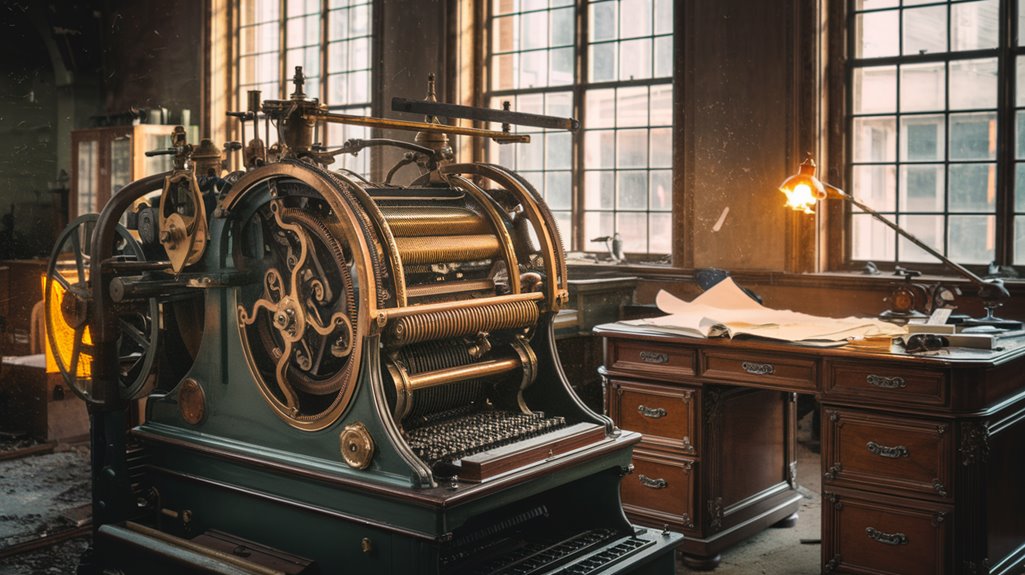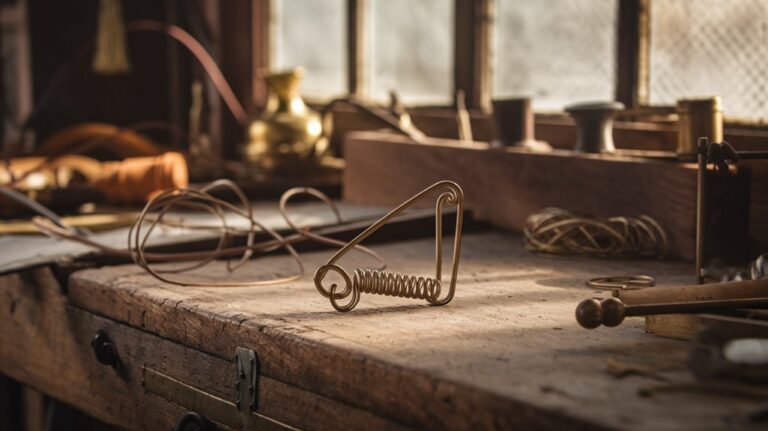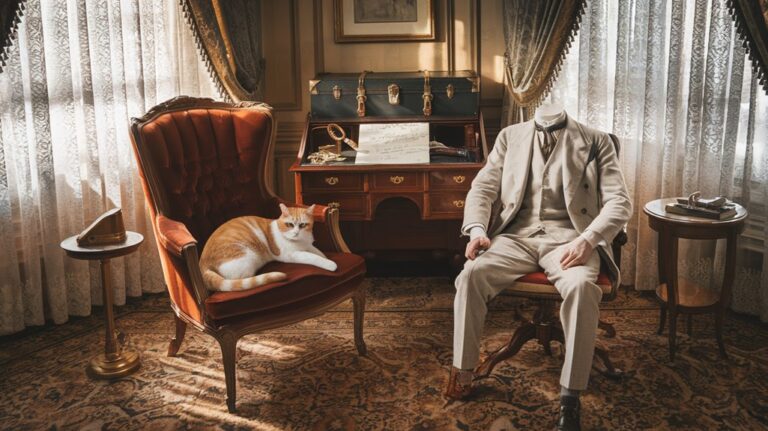Mark Twain’s Typesetting Machine: The Invention That Bled Him Dry
Like watching a fortune scatter in the wind, you can almost hear the rustle of Mark Twain's money slipping away—$300,000 worth, to be exact—as he chased the dream of a mechanical typesetter. You'll recognize the irony: America's most celebrated humorist, known for his wit and wisdom, fell prey to an inventor's elaborate promises. What drove this literary giant to bet everything on an unproven machine? The answer reveals a fascinating tale of ambition, innovation, and spectacular miscalculation.
The Birth of a Revolutionary Typesetting Dream
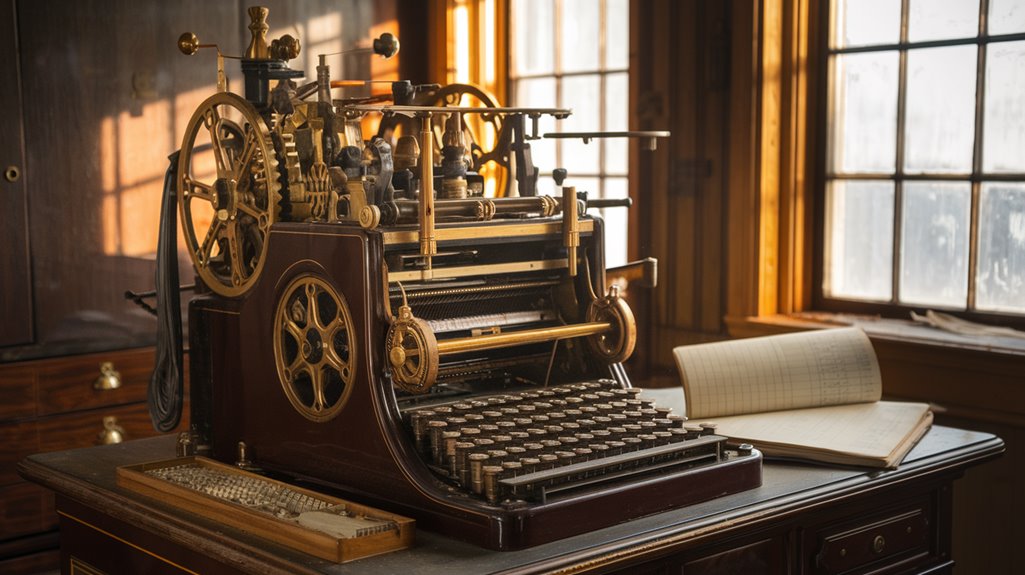
In 1874, James Paige's vision for revolutionizing the printing industry took shape when he patented the Paige Compositor, a groundbreaking typesetting machine.
You'll find this typesetting innovation remarkable for its time, as it promised to transform the laborious process of manual type composition.
When Paige joined the Farnham Company in 1877, he tackled the mechanical challenges that had stumped inventors for decades.
His ambitious project caught the attention of Mark Twain, whose fascination with technology made him an ideal investor.
Between 1872 and 1888, Paige refined his creation, producing a machine of stunning complexity with 18,000 parts.
The machine claimed to be 60% faster than Linotype, though this advantage would prove meaningless due to its impracticality.
Twain's investment in the Paige Compositor proved disastrous, leading him to face severe bankruptcy and ultimately requiring a worldwide lecture tour to pay off his debts.
Inside the Paige Compositor's Complex Machinery
The remarkable complexity of the Paige Compositor's inner workings reveals why it captivated inventors and investors alike.
You'd be astounded by its mechanical precision, featuring over 18,000 parts working in perfect harmony through an intricate system of bearings, cams, and springs.
The innovative design allowed a single operator to achieve speeds of 12,000 ems per hour while producing book-quality typesetting. Despite its impressive capabilities, the machine required continual adjustments to maintain functionality. Samuel Clemens lost his Huckleberry Finn royalties financing the ambitious project.
Its keyboard, arranged by syllables and words, controlled 109 characters, while the distribution mechanism efficiently lifted and placed type onto supporting shelves.
When a channel filled with 200 characters, the machine would automatically stop.
Engineers praised its cam mechanism as exemplary, noting how it could simultaneously distribute and set type during a single cam-shaft revolution – a demonstration of its sophisticated engineering.
Mark Twain's Fatal Financial Gamble
Despite his initial skepticism, Mark Twain's fascination with the Paige Compositor led him to make what would become the most catastrophic investment of his life – pouring $300,000 (nearly $7 million in today's money) into a machine that promised to revolutionize typesetting.
Twain's optimism blinded him to the mounting evidence of financial misjudgment as he continued funding the project through its darkest hours. The complex machine with its 18,000 moving parts proved far too intricate to operate reliably. In 1887, after years of development and Twain's steady investment, Paige finally completed a working prototype.
You can trace his downward spiral through these pivotal moments:
- Depleted his personal royalties and his wife's inheritance
- Watched his publishing house collapse in 1890
- Continued investing despite the machine's persistent breakdowns
- Ignored the success of the competing Linotype machine
- Lost nearly his entire fortune when the project finally dissolved
The venture ultimately forced him into bankruptcy, proving that even literary genius doesn't guarantee business acumen.
The Rise of Linotype and a Market Lost
While Mark Twain poured his fortune into the Paige Compositor, a revolutionary invention called the Linotype was quietly transforming the printing industry.
You'd be amazed at the Linotype advantages that made it the clear market winner: a skilled operator could produce up to 6,000 ems per hour, dwarfing the 250 ems possible with hand-setting type.
The typesetting evolution was swift and decisive. By 1911, you'd find 25,000 Linotype machines operating across the United States, and that number more than quadrupled to 100,000 by 1954.
Thomas Edison himself dubbed it the eighth wonder of the world.
Unlike the complex and costly Paige Compositor, Mergenthaler's invention proved economically viable and reliable. The machine's independent matrix system, developed in 1885, allowed for easier error correction and greater flexibility in typesetting. With its innovative 90-key keyboard and automatic matrix redistribution system, the Linotype became the backbone of newspaper and book production, dominating the market until computerized typesetting emerged in the 1960s.
From Literary Fortune to Bankruptcy
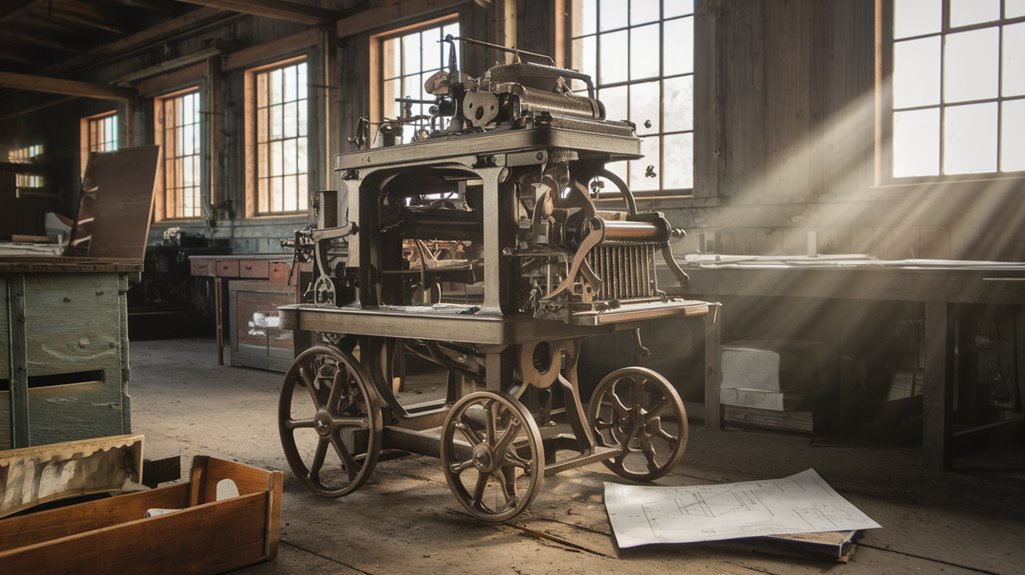
Believing in the revolutionary potential of the Paige Compositor, Mark Twain invested $300,000 of his literary earnings into its development, only to watch his fortune crumble.
His technological optimism led to severe financial consequences as James Paige's endless tinkering and machine complexities consumed more resources. The Linotype machine's success ultimately sealed the fate of Twain's investment.
The investment lessons from Twain's financial disaster were costly:
- His publishing house collapsed in 1890
- His wife's inheritance was depleted
- They faced severe financial difficulties
- He was forced into bankruptcy
- He learned never to invest more than he could afford to lose
You'll find a stark reminder of this venture's toll in the surviving prototype at the Mark Twain Memorial in Hartford, Connecticut – a monument to how even literary genius couldn't protect against the perils of overzealous technological investment.
The Legacy of a Failed Innovation
The Paige Compositor's failure left an enduring mark on both technological innovation and printing history.
With its staggering 18,000 parts, the Compositor stands as a demonstration of how intricate engineering can doom even the most promising innovations.
 9,000 to 12,000 ems per hour made its ultimate failure even more dramatic.
9,000 to 12,000 ems per hour made its ultimate failure even more dramatic.
The technological lessons learned from this failed innovation remain relevant today: simpler solutions, like the Linotype, often triumph over more sophisticated ones.
You can still see the sole surviving Compositor at the Mark Twain House in Hartford, Connecticut, where it reminds visitors that innovation success isn't just about capability—it's about practicality and reliability. This is particularly poignant given that Mark Twain was the first author to submit a typewritten manuscript, showing his early embrace of new printing technologies.




